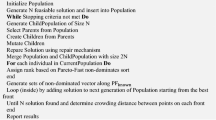Abstract
The product mix problem is one of the most important problems in production systems. Several algorithms to determine the product mix under the theory of constraints have been developed. Most of the previous works focused on one bottleneck (dominant bottleneck) and considered the product mix problem with exact data. In this paper, all bottlenecks are used in order to determine the aggregated priority of each product, and a multi-criteria decision-making approach is proposed for product mix problem with interval parameters. The proposed approach involves bottlenecks identification, determination of the production priority and the weights vector of bottlenecks, application of interval TOPSIS to calculate the aggregated priority of each product, and use of reducing and increasing process to improve the production plan. At the end, a numerical example is presented to illustrate the procedure of the proposed approach. The results obtained from the computational study have shown that the proposed algorithm is an effective approach to solve the product mix problem.
Similar content being viewed by others
References
Goldratt EM (1990) The Haystack Syndrome: sifting information from the Data Ocean? North River, New York
Luebbe R, Finch B (1992) Theory of constraints and linear programming: a comparison. Int J Prod Res 30(6):1471–1478
Patterson MC (1992) The product-mix decision: a comparison of theory of constraints and labor-based management accounting. Prod Invent Manag J 33(3):80–85
Lee TN, Plenert G (1993) Optimizing theory of constraints when new product alternatives exist. Prod Invent Manag J 34(3):51–57
Plenert G (1993) Optimized theory of constraints when multiple constrained resources exist. Eur J Oper Res 70(1):126–133
Fredendall LD, Lea BR (1997) Improving the product mix heuristic in the theory of constraints. Int J Prod Res 35(6):1535–1544
Hsu TC, Chung SH (1998) The TOC-based algorithm for solving product mix problems. Prod Plan Control 9:36–46
Onwubolu GC (2001) Tabu search-based algorithm for the TOC product mix decision. Int J Prod Res 39(10):2065–2076
Onwubolu GC, Mutingi MA (2001) Optimising the multiple constrained resources product mix problem using genetic algorithms. Int J Prod Res 39(9):1897–1910
Onwubolu GC, Mutingi MA (2001) Genetic algorithm approach to the theory of constraints product mix problems. Prod Plan Control 12(1):21–27
Aryanezhad MB, Komijan AR (2004) An improved algorithm for optimizing product mix under the theory of constraints. Int J Prod Res 42(20):4221–4233
Mishra N, Prakash TMK, Shankar R, Chan FTS (2005) Hybrid tabu-simulated annealing based approach to solve multi-constraint product mix decision problem. Expert Syst Appl 29(2):446–454
Souren R, Ahn H, Schmitz C (2005) Optimal product mix decisions based on the theory of constraints? Exposing rarely emphasized premises of throughput accounting. Int J Prod Res 43:361–374
Bhattacharya A, Vasant P, Sarkar B, Mukherjee SK (2008) A fully fuzzified, intelligent theory-of-constraints product-mix decision. Int J Prod Res 46(3):789–815
Wang JQ, Sun SD, Si SB, Yang HA (2009) Theory of Constraints product mix optimisation based on immune algorithm. Int J Prod Res 47(16):4521–4543
Rashidi Komijan A, Aryanezhad MB, Makui A (2009) A new heuristic approach to solve product mix problems in a multi-bottleneck system. J Ind Eng Int 5(9):46–57
Linhares A (2009) Theory of constraints and the combinatorial complexity of the product-mix decision. Int J Prod Econ 121:121–129
Sobreiro VA, Nagano MS (2012) A review and evaluation on constructive heuristics to optimise product mix based on the Theory of Constraints. Int J Prod Res 50(20):5936–5948
Tanhaei F, Nahavandi N (2013) Algorithm for solving product m ix problem in two-constraint resources environment. Int J Adv Manuf Technol 64:1161–1167
Alefeld G, Herzberger J (1983) Introduction to interval computations. Academic, New York
Jiang C, Han X, Liu GR, Liu GP (2008) A nonlinear interval number programming method for uncertain optimization problems. Eur J Oper Res 188:1–13
Jahanshahloo GR, Hosseinzadeh Lotfi F, Izadikhah M (2006) An algorithmic method to extend TOPSIS for decision-making problems with interval data. Appl Math Comput 175(2):1375–1384
Author information
Authors and Affiliations
Corresponding author
Rights and permissions
About this article
Cite this article
Badri, S.A., Ghazanfari, M. & Shahanaghi, K. A multi-criteria decision-making approach to solve the product mix problem with interval parameters based on the theory of constraints. Int J Adv Manuf Technol 70, 1073–1080 (2014). https://doi.org/10.1007/s00170-013-5360-8
Received:
Accepted:
Published:
Issue Date:
DOI: https://doi.org/10.1007/s00170-013-5360-8



